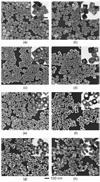Synthesis and Optical Properties of Cubic Gold Nanoframes
- PMID: 20200595
- PMCID: PMC2830659
- DOI: 10.1007/s12274-008-8046-z
Synthesis and Optical Properties of Cubic Gold Nanoframes
Abstract
This paper describes a facile method of preparing cubic Au nanoframes with open structures via the galvanic replacement reaction between Ag nanocubes and AuCl(2) (-). A mechanistic study of the reaction revealed that the formation of Au nanoframes relies on the diffusion of both Au and Ag atoms. The effect of the edge length and ridge thickness of the nanoframes on the localized surface plasmon resonance peak was explored by a combination of discrete dipole approximation calculations and single nanoparticle spectroscopy. With their hollow and open structures, the Au nanoframes represent a novel class of substrates for applications including surface plasmonics and surface-enhanced Raman scattering.
Figures





Similar articles
-
Robust synthesis of gold cubic nanoframes through a combination of galvanic replacement, gold deposition, and silver dealloying.Small. 2013 Sep 23;9(18):3111-7. doi: 10.1002/smll.201203233. Epub 2013 Mar 4. Small. 2013. PMID: 23457090
-
Direct synthesis of Au-Ag nanoframes by galvanic replacement via a continuous concaving process.Nanoscale. 2022 Jun 23;14(24):8825-8832. doi: 10.1039/d2nr01600a. Nanoscale. 2022. PMID: 35686613
-
One-Pot Self-Templated Growth of Gold Nanoframes for Enhanced Surface-Enhanced Raman Scattering Performance.ACS Appl Mater Interfaces. 2020 May 13;12(19):22050-22057. doi: 10.1021/acsami.0c04777. Epub 2020 May 4. ACS Appl Mater Interfaces. 2020. PMID: 32266808
-
Particle-in-a-Frame Nanostructures with Interior Nanogaps.Angew Chem Int Ed Engl. 2019 Oct 28;58(44):15890-15894. doi: 10.1002/anie.201908291. Epub 2019 Sep 18. Angew Chem Int Ed Engl. 2019. PMID: 31482631 Review.
-
Gold nanocages: from synthesis to theranostic applications.Acc Chem Res. 2011 Oct 18;44(10):914-24. doi: 10.1021/ar200061q. Epub 2011 Apr 29. Acc Chem Res. 2011. PMID: 21528889 Free PMC article. Review.
Cited by
-
Anisotropic nanomaterials: structure, growth, assembly, and functions.Nano Rev. 2011;2. doi: 10.3402/nano.v2i0.5883. Epub 2011 Feb 16. Nano Rev. 2011. PMID: 22110867 Free PMC article.
-
A new approach to solution-phase gold seeding for SERS substrates.Small. 2011 Feb 18;7(4):499-505. doi: 10.1002/smll.201001836. Epub 2011 Jan 3. Small. 2011. PMID: 21360809 Free PMC article.
-
Controlling the synthesis and assembly of silver nanostructures for plasmonic applications.Chem Rev. 2011 Jun 8;111(6):3669-712. doi: 10.1021/cr100275d. Epub 2011 Mar 11. Chem Rev. 2011. PMID: 21395318 Free PMC article. Review. No abstract available.
-
Facile chemical routes to mesoporous silver substrates for SERS analysis.Beilstein J Nanotechnol. 2018 Mar 14;9:880-889. doi: 10.3762/bjnano.9.82. eCollection 2018. Beilstein J Nanotechnol. 2018. PMID: 29600149 Free PMC article.
-
Plasmonic Multi-Layered Built-in Hotspots Nanogaps for Effectively Activating Analytes.Adv Sci (Weinh). 2024 Feb;11(7):e2306125. doi: 10.1002/advs.202306125. Epub 2023 Dec 3. Adv Sci (Weinh). 2024. PMID: 38044318 Free PMC article.
References
-
- Kim SW, Kim M, Lee WY, Hyeon T. Fabrication of hollow palladium spheres and their successful application to the recyclable heterogeneous catalyst for Suzuki coupling reactions. J. Am. Chem. Soc. 2002;124:7642–7643. - PubMed
-
- Sun Y, Xia Y. Increased sensitivity of surface plasmon resonance of gold nanoshells compared to that of gold solid colloids in response to environmental changes. Anal. Chem. 2002;74:5297–5305. - PubMed
-
- Portney NG, Ozkan M. Nano-oncology: Drug delivery, imaging, and sensing. Anal. Bioanal. Chem. 2006;384:620–630. - PubMed
-
- Chen J, Saeki F, Wiley BJ, Cang H, Cobb MJ, Li Z-Y, Au L, Zhang H, Kimmey MB, Li X, Xia Y. Gold nanocages: Bioconjugation and their potential use as optical imaging contrast agents. Nano Lett. 2005;5:473–477. - PubMed
-
- Chen J, Wiley BJ, Li Z-Y, Campbell D, Saeki F, Cang H, Au L, Lee J, Li X, Xia Y. Gold nanocages: Engineering their structure for biomedical applications. Adv. Mater. 2005;17:2255–2261.
Grants and funding
LinkOut - more resources
Full Text Sources
